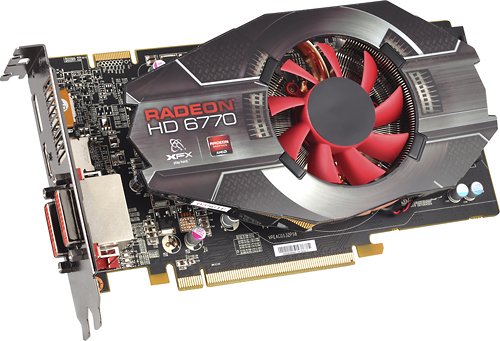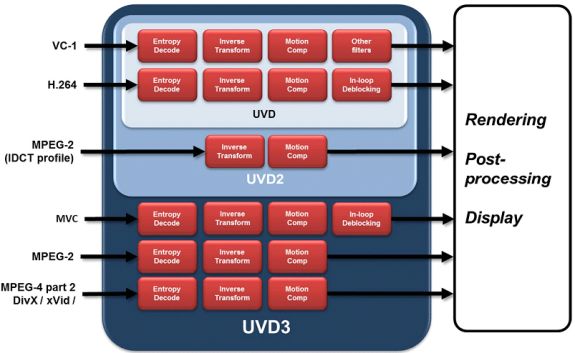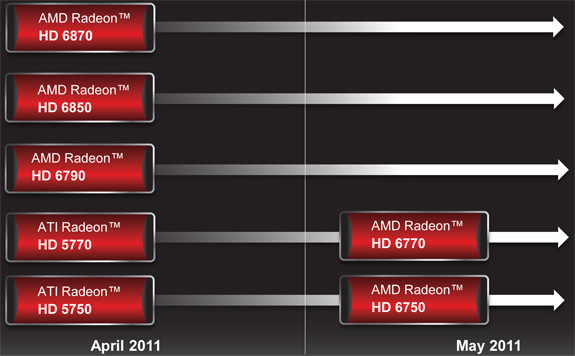AMD’s Radeon HD 6770 & Radeon HD 6750: The Retail Radeon 5700 Rebadge
by Ryan Smith on April 28, 2011 12:01 AM ESTWe haven’t talked about it beyond a passing comment, but AMD still has some Radeon 6000 series cards that are OEM-only. We are of course referring to the Radeon HD 6770 and Radeon HD 6750, AMD’s Juniper-powered 5770 & 5750 rebadges for OEMs. While we’ve only recently seen the rest of the Northern Islands lineup launch in the retail space, in the OEM space the last-generation Juniper GPU has been filling out AMD’s lineup between Turks (6500/6600) and Barts (6800) based video cards.
The rationale for OEM space is rather straightforward: OEMs want/need something new to sell. More RAM, a Sandy Bridge CPU, a SSD – their 2011 computers need to look better than their 2010 computers, as they certainly don’t want to be seen as selling last year’s model for anything less than a steep discount. It was perhaps a foolish hope that these shenanigans would remain in the OEM market, as so far AMD has continued to keep the 5770 and 5750 even after the rest of Northern Islands has launched. But here we are, out with the old and in with the old: the 5770 and 5750 are getting rebadged in retail. Say hello to the Radeon HD 6770 and Radeon HD 6750.
| AMD Radeon HD 6770 | AMD Radeon HD 5770 | AMD Radeon HD 6750 | AMD Radeon HD 5750 | |
| Stream Processors | 800 | 800 | 720 | 720 |
| Texture Units | 40 | 40 | 36 | 36 |
| ROPs | 16 | 16 | 16 | 16 |
| Core Clock | 850MHz | 850MHz | 700MHz | 700MHz |
| Memory Clock | 1.2GHz (4.8GHz data rate) GDDR5 | 1.2GHz (4.8GHz data rate) GDDR5 | 1.15GHz (4.6GHz data rate) GDDR5 | 1.15GHz (4.6GHz data rate) GDDR5 |
| Memory Bus Width | 128-bit | 128-bit | 128-bit | 128-bit |
| VRAM | 1GB | 1GB | 1GB | 1GB |
| FP64 | N/A | N/A | N/A | N/A |
| Transistor Count | 1.04B | 1.04B | 1.04B | 1.04B |
| Manufacturing Process | TSMC 40nm | TSMC 40nm | TSMC 40nm | TSMC 40nm |
| Price Point | ? | ~$110 | ? | ~$110 |
There’s really no way to sugarcoat it, and even AMD isn’t really trying. It’s the same Juniper GPU on the same boards with the same clocks, the same power requirements, and the same performance. The only thing different between a 5700 series card and its 6700 series counterpart is the sticker on the card, the BIOS, and quite possibly the price.

Image Courtesy Best Buy

Image Courtesy Newegg
However to be fair to AMD, they have at least made some effort to improve on the 6700 series over the 5700 series through the BIOS. As you may recall, one of the big differences for the 6000 series over the 5000 series is that the 6000 series got HDMI 1.4a support, along with a UVD3 video decoder that was capable of decoding the additional resolutions and bitrates Blu-Ray 3D’s MVC(H.264) profiles require. These changes have been backported to Juniper to some extent.
UVD2.2 is fast enough to process MVC, so now the 6700 series can decode Blu-Ray 3D. Without any hardware on hand we can’t specifically test this, but we suspect AMD may have introduced a new PowerPlay state (or edited an existing one) to further ramp up Juniper’s core clocks when playing MVC content, as this would be the most practical way to increase the max bitrate UVD2.2 can handle, if indeed it couldn’t handle MVC bitrates at the usual core clocks. Update: AMD has confirmed our theory. In fact the UVD3 also have a Blu-Ray 3D PowerPlay state, which means UVD2 and UVD3 may be more similiar than we once thought.
Meanwhile HDMI 1.3 and HDMI 1.4a both have the same bandwidth requirements, so now the 6700 series is HDMI 1.4a capable through some BIOS magic – although we haven’t been able to get confirmation that this support extends beyond support for the frame-packed formats required for HDMI 3D, or in other words it may not support 2K x 4K resolutions and other features normally associated with HDMI 1.4a. Update: AMD confirmed that the 6700 series only supports the HDMI 3D portions of the HDMI 1.4a spec. Apparently this is consistent with Northern Islands, whcih doesn't support 2K x 4K resolutions over HDMI either.

The good news here is that we’re not immediately aware of any reason why these features can’t be fully backported to existing 5700 series cards. Although AMD technically refers to UVD2.2 having “firmware”, as far as we know everything is contained in the video card’s BIOS. If this is the case, then for any 5700 series designs being recycled for the 6700 series, it should be easy to use the 6700 series BIOS. Of course this wouldn’t be something AMD supports.
Ultimately AMD considers this rebadging a necessity to some degree. While everyone is free to speculate on whether there are ulterior motives, what is clear is that the 5700 series created a branding problem for AMD: the 5000 series was launched before ATI was rebranded AMD. So the 5770 and 5750 are still technically “ATI” cards, this being nearly 8 months after ATI was fully rebranded to be part of AMD. At the same time this makes AMD’s product stack consistent from top to bottom for both retail and OEMs: every current card from the 6450 to the 6990 is now a 6000 series cards. It’s not a particularly good reason, but it is what it is.

Ultimately our biggest concern at this point is pricing. AMD tells us that 6700 series pricing will be consistent with 5700 series pricing, but we have our doubts. 5770 has actually been really good – it regularly goes on sale for as low as $95, so if you don’t mind a MIR and the choice of only a couple of vendors, you’ve been able to grab a 5770 for under $100. This is cheaper than the 5750 most of the time, never mind what it does to the 6670 and NVIDIA’s lineup. What is NVIDIA’s lineup? The slightly faster GTX 550 Ti at $125+, and the 5750-like GTS 450 at $90+. Compared to everything AMD and NVIDIA, the 5770 is a very good deal; and this is why we’re concerned about the pricing.
| Radeon HD 5700 Series Price History | |||||
| Launch | Today | Difference | |||
| Radeon HD 5770 | $160 | Approx $110 | -$50 | ||
| Radeon HD 5750 | $130 | Approx $110 | -$20 | ||
We hope to be proven wrong here, but at this point in time there’s little reason for AMD and their partners to sell $100 5770s when there’s no competitive pressure to do so. A good bargain is another name for a product bringing in less profit than it should, and in the cut-throat semiconductor industry you usually need to grab what you can when you can. The concern we have is that it’s as good a time as any to realign 5770 prices with the competitive market and AMD’s product stack – it’s time for a price hike. There is no doubt in my mind that the first 6700 cards will cost more than the cheapest 5700 cards. The only question is whether prices will come back down once stores are fully stocked with 6700 cards as they are today with 5700 cards.
At the end of the day this rebadging seems to only benefit AMD and their partners, to the detriment of buyers. In a weird twist it’s a bit better than how they handled the 6800 series – at least the 6700 series isn’t slower than the 5700 series – but that’s not saying much. Besides the backported MVC/HDMI 1.4a features, the 6700 series lacks everything else that made the rest of the 6000 series an improvement over the 5000 series. There’s no DisplayPort 1.2, no MPEG-2 or MPEG-4 ASP decoding, no color correction, no improved tessellator, and no linear space color correction. With the exception of perhaps DP1.2 they’re not headlining features, but they’re glaring inconsistencies.
When NVIDIA played the rebadge game with G92 it didn’t help consumers then, and with AMD doing it today, it doesn’t help consumers now. Actually, G92 ultimately got a die shrink from 65nm to 55nm and various clockspeed bumps, so unless AMD makes a 28nm Juniper core this may end up being a worse deal.
It’s perhaps with a twinge of sadness to see this happening to Juniper. Juniper above all other AMD GPUs has been AMD’s workhorse. It was the GPUs game developers first saw in the summer of 2009 when AMD sampled their first DX11 parts, and we’re now coming up on 2 years later where it’s still selling strong. We’re glad to see it live on – it’s a great card and continues to be so at $99, but the rebadging adds a permanent tarnish to the reputation; an air of taking advantage of uninformed buyers that it will never escape. This would seem to be the fate of any GPU fortunate to live long enough to cross multiple generations: if you aren’t replaced, you’re renamed.
| April 2011 Video Card MSRPs | ||
| NVIDIA | Price | AMD |
| $700 | Radeon HD 6990 | |
| $480 | ||
| $320 | Radeon HD 6970 | |
| $260 | Radeon HD 6950 2GB | |
| $240 | Radeon HD 6950 1GB | |
| $200 | Radeon HD 6870 | |
| $160 | Radeon HD 6850 | |
| $150 | Radeon HD 6790 | |
| $130 | ||
| ? | Radeon HD 6770 | |
| $99 | Radeon HD 6670 | |
| $95-$110 | ||
| $79 | Radeon HD 6570 | |
| $50-$70 | Radeon HD 5570 | |
| $55 | Radeon HD 6450 | |
| $30-$50 | Radeon HD 5450 | |










44 Comments
View All Comments
Battleflame - Thursday, April 28, 2011 - link
Does the UVD still make any sense now that there are plenty of players with support for DXVA?ViRGE - Thursday, April 28, 2011 - link
Eh? UVD is the fixed function video decoder that DXVA interfaces with.Belard - Thursday, April 28, 2011 - link
Don't play the idiotic nVidia game. Its confusing, stupid and hurts the reputation of the company.The 6790 is only slightly faster than the 5770 - yet its still a $150 for the 6790!?
The 6670 costs as much as a 5770, but is slower than the 5750.
Should have found a way to make a cheaper/slightly slower 6790 and call it 6770 and sell it for $100.
But this is a cheaper route - trying to fill in the $100~120 price hole.
We are not impressed.
Hrel - Thursday, April 28, 2011 - link
Display Port is stupid. I do NOT understand why everyone at Anandtech makes such a big deal about. I want it to do. I've never seen it on any monitors and I'm pretty sure no HDTV's have it on them. Also, as far as I know it doesn't support sound or 3D. HDMI is all we need. EVERYTHING else needs to die away, yesterday! Improved tesselation matters WAY more than stupid DP.Hrel - Thursday, April 28, 2011 - link
also, what's with the HD6790?Belard - Friday, April 29, 2011 - link
No, its not. You don't understand how the tech industry works.It takes YEARS for connectors and such to become standard. USB was available for 2-3 years before Apple started using it with their Macs... then it took off. Otherwise, it used to be a useless connector. OMG, VGA connectors is STILL alive and kicking - typically on bottom end PCs and monitors. ie: $80 monitors don't have DVI.
DVI is still not understood by many people today. Its not so bad thou, todays LCD monitors do a pretty good job of auto-sync to VGA. But I'll take DVI over it.
Display Port is similar to HDMI. But Display Port is royalty free. ($10k~100k+ a year per manufacture) ie: If I'm correct, HDMI royalty is per cable / device... such as the PC, the cable and the monitor.
Display Port (DP) has almost double the bandwidth over HDMI.
DP supports Audio and 3D.
DP has Multi-monitor support such as 4 monitors in 1920x1080 through a single cable. HDMI does NOT do that.
There are currently 7 PC monitors and Apple sells DP monitors. Apples 27" display (the only one they have) does 2560-by-1440. Snif... no 2560-by-1600.
marc1000 - Friday, April 29, 2011 - link
DP is also the video protocol implemented in intel Thunderbolt. by the way, thunderbolt uses DP cables and sends a PCIE link inside them.so it would be really nice to have only ONE connector on the entire computer, for everything from storage to displays, and even mouse/keyboard at some point.
at some point the TV's will switch do DP too.
DP only needed 2 revisions until now, while HDMI has been through 4. and it is still faster than HDMI.
von Krupp - Thursday, April 28, 2011 - link
I'm not surprised, really. What would surprise me is if the 6770 costs more than $120, because it has been AMD's recent tradition to have a product in every pricing segment and thereby saturate the entire market. Shotgun approach to sales, really. Look at the chart above: AMD has only three open slots and Nvidia has five. What's more, almost all of AMD's line up is made from HD6000 cards, where Nvidia has 200, 400, and 500 series cards. Higher numbers appeal to base consumer decision making.Belard - Friday, April 29, 2011 - link
Just thinking about it.What would have made more sense... is to name these 6750/6770 cards the "6650 and 6670". The 6790 is nothing like the 5770/6770...
The problem with naming these 6750/6770 cards is that the don't have the HD6000 feature set. Even thou they are slightly upgraded from the 5700s, there is no improvement in performance or video output.
The 6670 card is more advanced, even thou its a slower card. It would be a better choice for those who want some gaming abilities out of their HTPC systems.
von Krupp - Friday, April 29, 2011 - link
I agree. But at the end of the day the majority of consumers have no idea exactly what they are getting with each tier. All they see is 6770 > 6670, so they opt for the 6770 instead. They also see that 6770 > 460, so they opt for the AMD part. Nvidia does have more brand recognition than AMD/ATI, so that could level things out on that side.As for the 6790...that card just baffles me. It's the HD5830 all over again.